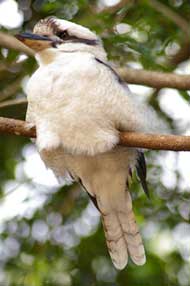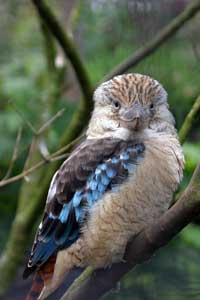|

Plumage:
The male Laughing Kookaburra can be easily distinguished from the female by the blue hues on his wing feathers and darker blue on his tail feathers. The female on the other hand has a small amount of aqua on her wing feathers, but no blue on her tail feathers.

 Kooky Kookaburras: Kookaburras are Kooky Kookaburras: Kookaburras are
best known for their unmistakable call which
is uncannily like loud, echoing human
laughter — good-natured if rather hysterical merriment in the case of the well-known Laughing Kookaburra (Dacelo novaeguineae), maniacial, almost insane cackling in
the case of the slightly smaller Blue-winged Kookaburra (Dacelo leachii).
Kookaburra Communication: Kookaburras occupy woodland territories in loose
family groups, and their laughter serves the
same purpose as a great many other
bird calls: to demarcate territorial borders.
The Laughing Kookaburra also "laughs" to greet its mate after periods of absences.
It can be heard at any time of day but most frequently shortly after dawn, and
especially when the colour drains from the
forest after sunset.
Laughing in the Trees: One bird starts with a low, hiccupping chuckle, then throws its head back in raucous laughter: often several others join in. If a rival tribe is within earshot and replies, the whole family soon gathers to fill the bush with ringing laughter. Hearing kookaburras in full voice is one of the more extraordinary experiences of the Australian bush; something even locals cannot ignore, and that visitors, unless forewarned, can be quite terrified by.
Hunting: Kookaburras hunt much as other kingfishers (or indeed robins) do: by perching on a convenient branch or wire and waiting patiently for prey to pass by: mice and similar-sized small mammals, large insects, lizards, small birds and nestlings, and most famously, snakes. Small prey are preferred, but kookaburras not infrequently take surprisingly large creatures, including venomous snakes a good deal longer than the bird itself.
All in the Family: Most species of Kookaburra tend to live in family units, with offspring helping the parents hunt and care for the next generation of offspring.
Kookaburras in the Backyard: The Laughing Kookaburra frequently inhabits suburban gardens and are so accustomed to humans that they will quite often eat out of your hand. It is not recommended to feed them however as it interferes with their basic dietary requirements and can lead to disease.

 Woo Her With Food: During mating season, the Laughing Kookaburra indulges in behaviour similar to that of a Wattle Bird. The female adopts a begging posture and vocalises like a young bird. The male then offers her his current catch accompanied with an "oo oo oo" sound. Woo Her With Food: During mating season, the Laughing Kookaburra indulges in behaviour similar to that of a Wattle Bird. The female adopts a begging posture and vocalises like a young bird. The male then offers her his current catch accompanied with an "oo oo oo" sound.
They start breeding around October/November. If the first clutch fails, they will continue breeding into the summer months.
Nest and Nestlings: They generally lay three eggs at about 2 day intervals. If the food supply is not adequate the third egg will be smaller and the third chick will also be smaller and at a disadvantage to its larger siblings. Chicks have a hook on the upper mandible, which disappears by the time of fledging.
If the food supply to the chicks is not adequate the chicks will quarrel and the hook can be used as a weapon and the smallest chick can be killed by its larger siblings. If food is plentiful the parent birds spend more time brooding the chicks and so the chicks are not able to fight.

Species Rivalry: Unusually for close relatives, the Laughing and Blue-winged species are direct competitors in the area where their ranges overlap. This suggests that the two species, though having common stock, evolved in isolation (possibly during a period when Australia and New Guinea were more distant — see Australia-New Guinea) and were only brought back into contact in relatively recent geological times.
Trivia: Olly the Kookaburra was one of the three mascots chosen for the Sydney 2000 Olympics. The other mascots were the Echidna and the Platypus.
All text is available under the terms
of the GNU Free Documentation License
|